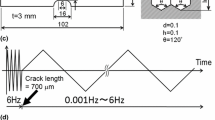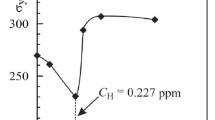We reveal various microfractographic signs of crack propagation in steels under the influence of hydrogenating media. These signs are related to the transportation of hydrogen in the process zone at the crack tip according to the diffusion or dislocation mechanisms. The intergranular fracture under cyclic loading shows that the hydrogen diffusion along grain boundaries is predominant. The transgranular fracture is caused by the combined action of the dislocation mechanism responsible for the intense hydrogenation of the metal along slip bands and the diffusion mechanism promoting the redistribution of hydrogen along the interfaces inside the grains.


Similar content being viewed by others
References
O. M. Romaniv, Yu. V. Zyma, and H. V. Karpenko, Electron Fractography of Hardened Steels [in Ukrainian], Naukova Dumka, Kiev (1974).
O. Z. Student, W. Dudziński, H. M. Nykyforchyn, and A. Kamińska, “Effect of high-temperature degradation of heat-resistant steel on the mechanical and fractographic characteristics of fatigue crack growth,” Fiz.-Khim. Mekh. Mater., 34, No. 4, 49–58 (1999); English translation : Mater. Sci., 35, No. 4, 499–508 (1999).
O. Z. Student, A. D. Markov, and H. M. Nykyforchyn, “Specific features of the influence of hydrogen on the properties and mechanism of fracture of the metal of welded joints of steam pipelines at thermal power plants,” Fiz.-Khim. Mekh. Mater., 42, No. 4, 26–35 (2006); English translation : Mater. Sci., 42, No. 4, 451–460 (2006).
N. Taylor, H. M. Nykyforchyn, O. T. Tsyrulnyk, and O. Z. Student, “Effect of hydrogenation on the fracture mode of a reactor pressure-vessel steel,” Fiz.-Khim. Mekh. Mater., 45, No. 5, 5–16 (2009); English translation : Mater. Sci., 45, No. 5, 613–625 (2009).
O. P. Ostash and V. I. Vytvyts’kyi, “Duality of the action of hydrogen on the mechanical behavior of steels and structural optimization of their hydrogen resistance,” Fiz.-Khim. Mekh. Mater., 47, No. 4, 5–19 (2011); English translation : Mater. Sci., 47, No. 4, 421–437 (2012).
V. M. Sidorenko, V. V. Fedorov, L. V. Barabash, and V. I. Pokhmurskii, “Acceleration of self-diffusion processes in metals under the influence of dissolved hydrogen,” Fiz.-Khim. Mekh. Mater., 13, No. 6, 27–30 (1977); English translation : Mater. Sci., 13, No. 6, 607–610 (1978).
Y. Katz, N. Tymiak, and W. W. Gerberich, “The dynamic nature of hydrogen assisting crack extension,” J. Achiev. Mater. Manufact. Eng., 18, Nos. 1–2, 123–126 (2006).
H. M. Nykyforchyn, O. Z. Student, H. V. Krechkovs’ka, and A. D Markov, “Evaluation of the influence of shutdowns of a technological process on changes in the in-service state of the metal of main steam pipelines of thermal power plants,” Fiz.-Khim. Mekh. Mater., 46, No. 2, 42–54 (2010); English translation : Mater. Sci., 46, No. 2, 177–189.
C. D. Beachem, “A new model for hydrogen-assisted cracking (hydrogen “embrittlement”),” Metallurg. Trans., 3, No. 2, 441–455 (1972).
SOU 40.3–0013044–20:2010. Normative Act. Directive. Estimation of the Engineering State of the Metal of Direct Sections of the Main Steam Pipelines of TPPs. Influence of Shutdowns of the Technological Process on the Engineering State of the Operating Metal. Standard Instruction [in Ukrainian], LKB State Company, Karpenko Physicomechanical Institute, Ukrainian National Academy of Sciences, Lviv (2010).
H. V. Krechkovs’ka, O. Z. Student, A. I. Kutnyi, H. M. Nykyforchyn, and P. Ya. Sydor, “Brittle-fracture resistance of the metal of hyperboloid gridshell Shukhov tower,” Fiz.-Khim. Mekh. Mater., 50, No. 4, 87–93 (2014); English translation : Mater. Sci., 50, No. 4, 578–584 (2015).
Author information
Authors and Affiliations
Corresponding author
Additional information
Translated from Fizyko-Khimichna Mekhanika Materialiv, Vol. 51, No. 4, pp. 67–70, July–August, 2015.
Rights and permissions
About this article
Cite this article
Krechkovs’ka, H.V. Fractographic Signs of the Mechanisms of Transportation of Hydrogen in Structural Steels. Mater Sci 51, 509–513 (2016). https://doi.org/10.1007/s11003-016-9869-5
Received:
Published:
Issue Date:
DOI: https://doi.org/10.1007/s11003-016-9869-5




